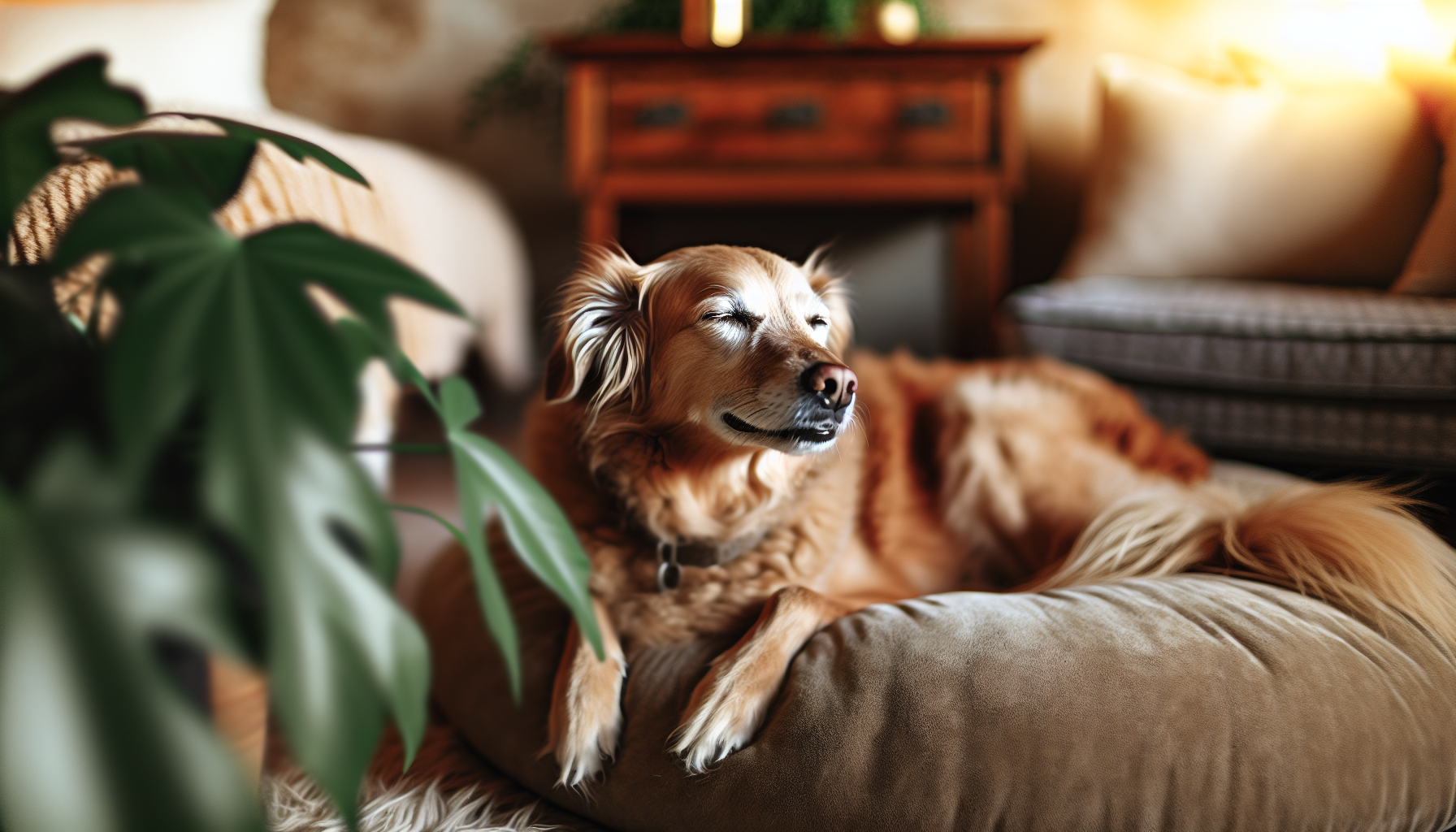What do calming treats do for dogs? Simply put, they ease stress and anxiety. Whether it’s the boom of fireworks, the stress of travel, or the pangs of separation anxiety, calming treats can offer your dog a sense of tranquility with safe, natural ingredients. This article delves into how these treats work, their ingredients, and what to consider when choosing them for your canine companion.
Key Takeaways
- Calming treats use natural ingredients and amino acids, such as melatonin, L-theanine, and chamomile, to alleviate dogs’ stress without sedation and support overall well-being.
- Effective in various stress-inducing situations, calming treats can help dogs with travel anxiety, noise phobias, and separation anxiety, but are best used as part of a broader management strategy.
- There’s a need for careful selection of calming treats based on dog’s needs, considering factors like anxiety triggers, allergies, and dietary restrictions, and consulting a vet is key for safe integration into their diet.
Calming treats use certain natural ingredients and amino acids to foster relaxation and ease mild stress and anxiety. These calming products, akin to calming supplements for humans, are designed to provide health and medical benefits. They help dogs cope with stressful situations without the need for sedation.
Key ingredients like L-tryptophan, hemp seed powder, and organic ginger root contribute to promoting relaxation, normal brain function, and maintaining normal inflammatory pathways. Every ingredient plays a vital role – from antioxidants for overall well-being to ingredients that aid proper digestion, all while offering a delicious peanut butter flavor.
Natural Ingredients
Common ingredients in calming treats for dogs include:
- Melatonin: prepares the body for rest
- L-theanine: stimulates relaxation without causing drowsiness
- Valerian root: promotes contentment
- Chamomile: has relaxing properties thanks to compounds like apigenin and luteolin
Together, these ingredients synergistically support stress management in dogs.
For example, Solid Gold Calming Chews and Zesty Paws Calming Bites contain a blend of natural ingredients. Their effectiveness is backed up by both clinical testing and solid customer testimonials, making them trusted choices for many pet owners.
Amino Acids and Hormones
Amino acids and hormones play a critical role in regulating a dog’s mood and emotions, influencing how they respond to stress. L-Theanine, an amino acid, can increase serotonin and dopamine levels, promoting relaxation without causing drowsiness. Additionally, L-Tryptophan, an essential amino acid, assists dogs in coping with external stresses by being converted into serotonin.
Melatonin helps regulate mood and the sleep-wake cycle in dogs, reducing anxiety. Vitamin B6, on the other hand, plays a pivotal role in serotonin production, while other B Vitamins support neurological health essential for maintaining normal brain and nerve function.
Situations Where Calming Treats Can Help


Calming treats shine in various situations that can cause significant stress for dogs, such as fears, phobias, vet visits, and anxiety. These treats are particularly handy in alleviating anxiety during thunderstorms, car rides, and other travel-related stressful events. For maximum effectiveness, calming treats should be administered before the dog is exposed to a known stress trigger.
Thinking back to our thunderstorm scenario, a well-timed calming treat could help your trembling pooch stay calm amidst the storm, making the experience less traumatic for both of you.
Travel Anxiety
Travel can be a significant stressor for dogs. The unfamiliar environments, movement, and noise can cause anxiety, leading to restlessness or even motion sickness. Calming treats can help dogs cope with car rides, plane trips, and new environments, making travel a more pleasant experience for everyone involved.
So, the next time you’re planning a family road trip, remember to pack some calming treats for your furry friend. It might just make the difference between a peaceful journey and a stressful ordeal.
Loud Noises and Phobias
Loud noises such as thunderstorms or fireworks can trigger anxiety in dogs, causing behaviors like excessive barking or hiding. Calming treats are an effective intervention for dogs experiencing noise phobias, helping them stay calm during these anxiety-inducing situations.
In addition to calming treats, behavioral training methods like desensitization and counterconditioning can enhance overall anxiety management. These techniques involve:
- Gradual exposure to the trigger
- Pairing the exposure with positive experiences
- Helping your dog learn to associate the once feared noise with positive emotions.
Separation Anxiety
Separation anxiety is a common issue for many dogs, characterized by distress when left alone or separated from their owners. Calming treats are specifically formulated to ease this anxiety, providing a sense of calm during these times.
Nonetheless, calming treats should be incorporated into a broader anxiety management strategy, rather than being used as the sole solution. Combining these treats with other techniques such as:
- Behavioral training
- Exercise and physical activity
- Environmental enrichment
- Regular routines and structure
can lead to more effective results.
Choosing the Right Calming Treat for Your Dog
Several key factors should be considered when selecting the most suitable calming treat. These include:
- The type of anxiety and the specific circumstances that cause distress to your dog
- Your dog’s size, breed, temperament, and taste preferences
- Treats that can be easily added to your dog’s regular diet without major disruptions to their nutritional balance
In addition, choosing the best calming treats that have undergone clinical testing or have solid customer testimonials can ensure their effectiveness. Remember, not all calming treats are created equal, so it’s essential to select ones from reputable manufacturers for your dog’s safety and well-being.
Assessing Your Dog’s Anxiety Levels
Before deciding on calming treats, evaluating your dog’s anxiety levels is crucial. Signs of anxiety in dogs can include:
- Excessive barking
- Panting
- Restlessness
- Showing signs of nervousness such as pacing or hiding
By observing your dog’s behavior in various situations, you can identify if they are overly reactive to their surroundings, which could indicate stress or anxiety.
Behavioral assessment tools, such as questionnaires and scales, can also help quantify a dog’s anxiety levels. This information can guide your selection of calming treats, ensuring you choose a product that’s tailored to your dog’s specific needs.
Considering Allergies and Dietary Restrictions
Another significant consideration when choosing calming treats is allergies and dietary restrictions. Consulting with a veterinarian is important if your dog has any known allergies or dietary restrictions. Additionally, always read the ingredients and test feed a new treat to ensure your dog digests it well and has no side effects.
For dogs with specific dietary requirements, there are different types of calming treats available:
- Organic calming treats
- Grain-free calming treats
- Hypoallergenic calming treats, which exclude common allergens like beef, chicken, and grains
- Single-ingredient calming treats, which contain only one protein source and are beneficial for dogs with food sensitivities, reducing the risk of allergic reactions.
Consulting with a Veterinarian
It is crucial to consult a veterinarian before introducing calming treats to your dog’s diet. A veterinarian can provide strategic recommendations and flag any unsuitable ingredients, ensuring the appropriate usage and safety of the treats. It’s also vital to ensure that calming treats do not interfere with your dog’s medication or aggravate any chronic health issues.
Moreover, a veterinarian can:
- Guide the proper dosage of calming treats
- Monitor for any potential side effects
- Provide insights on how calming treats work
- Advise on when they’re most effective
- Determine whether your dog’s anxiety indicates more serious health concerns.
Combining Calming Treats with Other Stress-Relief Techniques


The effectiveness of calming treats can be boosted when combined with other stress-relief techniques. A comprehensive approach to managing a dog’s emotional stability might include:
- pharmaceuticals
- behavioral interventions
- alternative therapies
- lifestyle changes
- various tools
These can be utilized alongside dog calming treats to further alleviate a dog’s anxiety, and incorporating dog treats into their routine can also provide positive reinforcement.
For instance, integrating behavioral training and environmental modifications, as well as alternative therapies like pheromone diffusers and puzzle toys, can complement the stress-relieving effects of calming treats. This multi-modal approach is often more effective than relying solely on calming treats.
Behavioral Training and Modification
Behavioral training is a key component in a comprehensive strategy to treat anxiety in dogs. By providing dogs with the skills to cope with stress-inducing situations, behavioral training can significantly improve their quality of life. In some instances, a professional may even recommend medication to work alongside behavioral training for more effective anxiety management.
Remember, a combination of methods is often advised for anxious dogs. Anxiety wraps, medication, and behavioral training can all contribute to effectively managing anxiety. This approach ensures your dog is equipped with a variety of tools to handle their anxiety, rather than depending solely on calming treats.
Environmental Changes
Creating a comfortable living space for a dog can greatly reduce their stress levels, especially when paired with calming treats. Here are some tips to create a tranquil environment for your dog:
- Maintain consistent daily routines to help dogs feel secure and minimize anxiety.
- Use pheromone diffusers to provide additional stress relief.
- Establish a dedicated safe space where your dog can retreat to when they need a break.
Pairing good calming treats with these stress-relief methods can enhance their effectiveness and create a peaceful environment for your calming dog.
So, next time a thunderstorm rolls in, you might consider preparing a cozy, sound-resistant den for your dog to retreat to, equipped with their favorite toys and some calming treats.
Alternative Therapies
Alternative therapies can complement the stress-relieving effects of calming treats. Some options to consider are:
- Pheromone diffusers, like Adaptil®, which create a calming environment for dogs and help manage stress and anxiety.
- Pressure wraps, such as the ThunderShirt®, which promote a sense of well-being by releasing endorphins through gentle pressure.
- Puzzle toys and snuffle mats, which provide mental stimulation and help distract and soothe dogs during times of stress.
Even aromatherapy toys infused with dog-safe essential oils, such as lavender, can provide a calming sensation. As long as the intensity of the scent is appropriate for a dog’s sensitive nose, such toys can be a great addition to a comprehensive anxiety management strategy.
Safety and Precautions with Calming Treats


Although calming treats can be beneficial in managing your dog’s anxiety, awareness of safety precautions is crucial. The regulatory status of calming treats for dogs is not heavily regulated, meaning quality and safety can vary significantly between brands. Therefore, it’s critical to select treats from reputable manufacturers known for their safety and efficacy.
Moreover, high-quality calming treats should be made with certified organic ingredients, free of artificial preservatives and fillers, and include whole food ingredients. Terms such as ‘natural’ and ‘organic’ on calming treat labels do not automatically guarantee the product’s safety or quality, underlining the importance of careful selection.
Monitoring Side Effects
Keeping an eye out for side effects in your dog is an important aspect of using calming treats. Side effects such as:
- sleepiness
- lethargy
- behavioral changes
- digestive upset
can occur if the treats are overconsumed. Therefore, it’s important to keep a close eye on your dog’s reaction to the treats and adjust the type or dosage as needed.
Additionally, calming treats should be free of psychoactive effects like THC to ensure they are calming treats safe for canine consumption. Always consult a veterinarian to confirm there are no risks of adverse interactions between calming treats and any other supplements or medications your dog may be taking.
Following Dosage Instructions
Adhering to the suggested dosage instructions for calming treats is an additional vital safety measure. Dosage guidelines are typically provided on the product packaging and should be based on a dog’s size, age, and health condition. This is important to prevent overdosing and ensure the treats are administered at the right time according to your dog’s needs.
For instance, NaturVet Quiet Moments Calming Aid recommends administering the treats 30 minutes prior to travel for the best results. Always consult with a veterinarian for professional advice on dosage and timing.
Checking for Quality and Transparency
Ensuring the quality and transparency of calming treat ingredients is vital for your dog’s wellbeing. Differences can exist between brands with regards to their sourcing and manufacturing processes, and the FDA does not heavily regulate dog supplements. Therefore, it’s important to prioritize purchasing calming treats from credible suppliers known for their safety and efficacy.
Reporting any adverse effects associated with animal products to agencies like the FDA can help maintain awareness of the quality and safety of calming treats in the market. And remember to exercise caution with calming treats containing CBD or other unapproved drugs due to uncertainties surrounding their safety, effectiveness, and proper dosing.
Summary
In conclusion, calming treats can be an effective tool to help soothe your dog’s nerves and navigate stressful situations. They harness the power of natural ingredients and amino acids to promote relaxation and alleviate mild stress and anxiety. When selecting the right calming treat, considering your dog’s anxiety levels, allergies, and dietary restrictions, alongside consultation with a veterinarian, is crucial. Combining calming treats with other stress-relief techniques and monitoring for side effects can enhance their effectiveness and ensure your dog’s safety. So next time a thunderstorm is rolling in, you’ll be ready to help your furry friend stay calm and relaxed.

